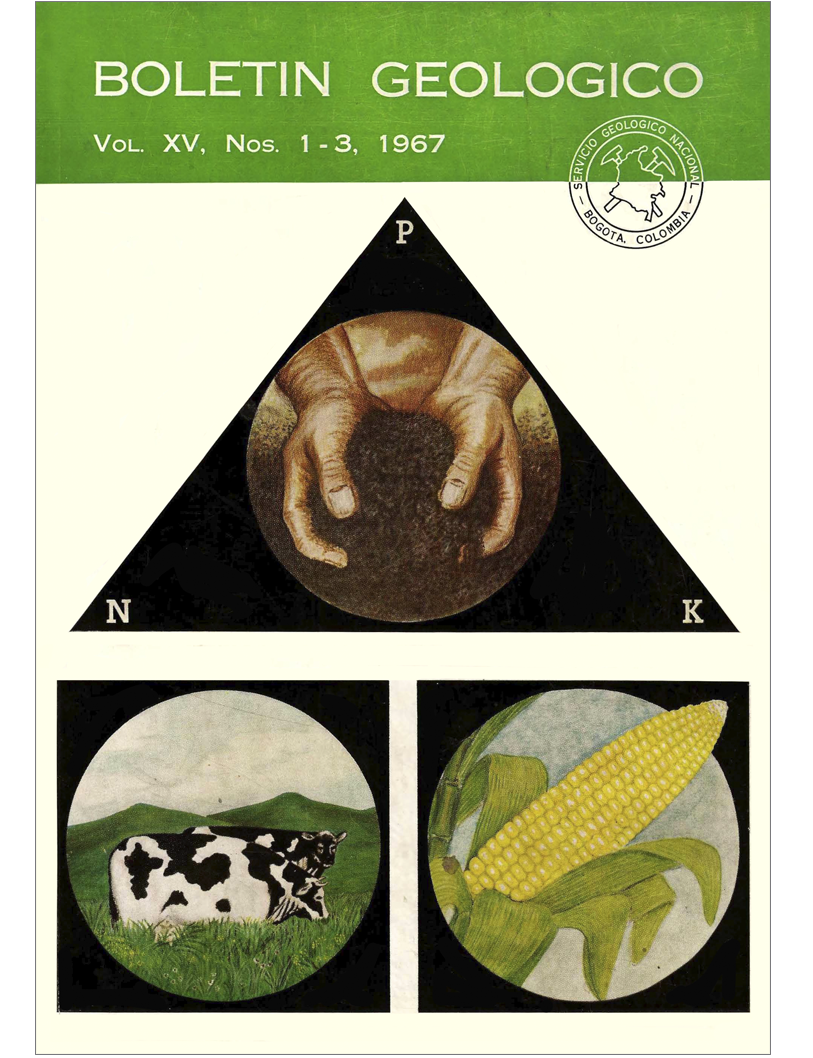New techniques in prospecting for phosphate deposits
DOI:
https://doi.org/10.32685/0120-1425/bolgeol15.1-3.1967.98Keywords:
Colombia, phosphorite sedimentation, phospharite facies, phospharite availability, disposalsDownloads
How to Cite
Issue
Section
Published
Abstract
Two decades ago, phosphorus was called the "bottleneck" for alleviating world hunger.
In South America, Asia, and other large areas of the earth, it was believed that there were no local sources of this vital fertilizer. Now the outlook is much more encouraging, partly because a few major deposits have been developed, but mainly because technological advances promise more phosphate will be available in the future.
Among these advances, the following are of particular significance in the fields of beneficiation and fertilization technology: a) A variety of washing and flotation techniques, which now make possible the production of commercial concentrates from unconsolidated deposits with a low P2Q5 content between 5 and 10 percent (1); b) Newly found phosphate fertilizers that do not need sulphuric acid or need less than the usual amount to produce ordinary varieties of superphosphate, which is why they have been found to have a low P2Q5 content (1); c) Newly found phosphate fertilizers that do not need sulphuric acid or need less than the usual amount to produce the ordinary varieties of superphosphate, which is why they have been found to have a low P2Q5 content, which can be manufactured where sulphuric acid is scarce (2); c) Certain phosphorites, some high in hydroxylapatite, dissolve relatively easily in soil solutions (judging by their neutral solubility to ammonium citrate); they can therefore be applied directly without treatment as fertilizers in many soils so that their market price can be reduced. Examples are the deposits on the island of Curacao, some in North Africa (3), and the phosphorites recently discovered in the Sechura Desert in Peru (4). Furthermore, experiments carried out by the Instituto de Pesquisas Agronómicas of Brazil, with the cooperation of technicians from the U.S. Agency for International Development, indicate that the common phosphorites, which are relatively insoluble when applied in most temperate climate soils, can be used effectively in the acidic soils of the tropics (5). All these factors will help to increase the geographical availability and decrease the costs of phosphate fertilizers.
Equally important in increasing the geographic availability of phosphorite is the improved knowledge of the origin of marine phosphorites gained from extensive studies of the Permian "Phosphoria" formation in the western United States (6) and (7) and from analysis of the modern marine environment in which phosphorites are currently forming (6), (8), (10). This better understanding of the origin and occurrence of marine phosphorites provides useful guidelines in prospecting since it makes possible the recognition of geographic areas and geological formations favorable for the occurrence of an important class of phosphorites. This topic, useful geological guidelines for prospecting, and its genetic basis, are the study's main objective.
References
(1) RUHLMAN, E. R., Phosphate rock: Part 1, Mining, beneficiation and marketing: U.S. Bureau of Mines Info. Circular 7814, 33 pp. (1958).
(2) WALTHALL, J. H., Chemistry and technology of new phosphate materials, 205-255 in Fertilizer technology and resources in the United States, Agronomy Mon. 3, Acad. Press, New York (1953).
(3) JACOB, K. D., W. L. HILL, Laboratory evaluation of phosphate fertilizers, 209-34.6, in Soil and fertilizer phosphorus in crop nutrition: Agronomy Mon. 3, Acad. Press, New York (1953).
(4) CHENEY, T. M., Written communication (1961).
(5) HAYNES J. L., Written communication (Oct. 1961).
(6) McKELVEY, v. E., R. W. SWANSON, R. P. SHELDON, The Permian phosphate deposits of western United States: 19th Internat. Geol. Cong. Comptes Rendus, sec. II, 45-64 (1953).
(7) McKELVEY, V. E., J. S WILLIAMS, R. P. SHELDON, E. R. CRESSMAN, T. M. CHENEY, R. W. SWANSON, The Phosphoria, Park City, and Shedhorn formations in the western phosphate field: U. S. Geol. Survey Prof. Paper 313-A, 1/47 (1959).
(8) KAZAK0V, A. V., The phosphorite facies and the genesis of phosphorites: Trans. Sci. Inst. Fertilizers and Insecto-fungicides, N° 142 (published for the 17th Internat. Geol. Cong.) Leningrad, 95-113 (1937).
(9) BRONGERSMA-SANDERS, M., Mass mortality in the sea: Treatise on marine ecology and paleocology, Ch. 29, 941-1010, I, Ecology. Geol. Soc. American Mem. p. 67 (1957).
(10) McKELvEY, V. E., Relation of upwelling marine watcrs to phosphorite and oíl (abs.) Geol. Sec. America Bull., 70, p. 1783 (1959).
(11) SVERDRUP, H. U., M. w. JOHNSON, R. H. FLEMING, The Oceans: PrenticeHall, New York, 1086 pp. (1946).
(12) FLEMING, R. H., General features of the ocean: Ch. 5, 87-108 in Treatise on marine ecology and paleoecology I, Ecology, Geol. Soc. America Mem. p. 67 (1957).
(13) MERO, J. L., Sea floor phosphorite: California ·Mineral lnf. Service 14, N° II, 1-12 ( 1961).
(14) GARDNER, L. S., Phosphate deposits of the Teton Basin area, Idaho and Wyoming: U .S. Geol. Survey Bull. 944-A, 1/37 (1944).
(15) SHAPIRO, L., Simple field method for the determination of phosphate in phosphate rocks: Am. Mineralogist, 37, 341-342 (1952).










